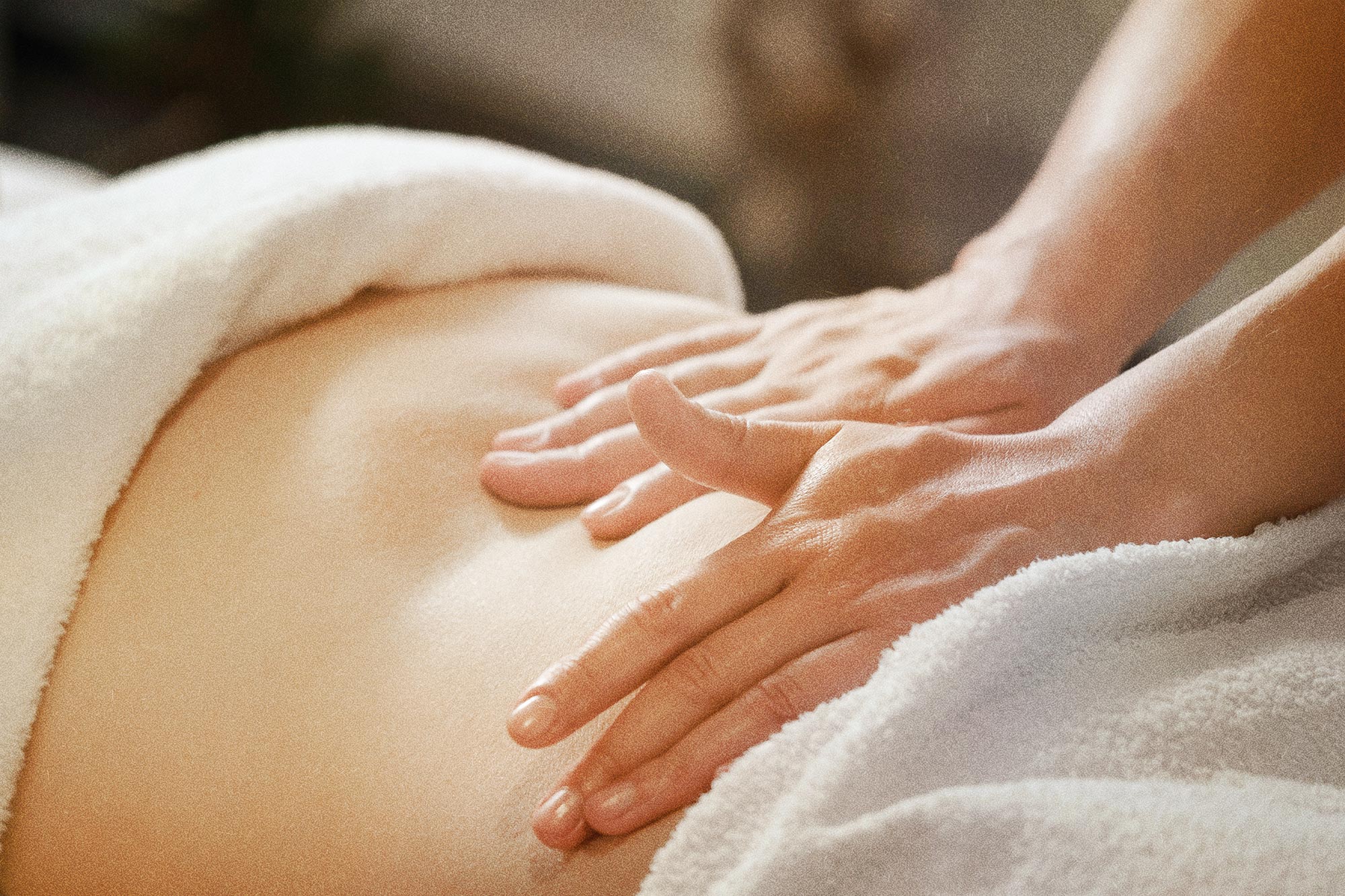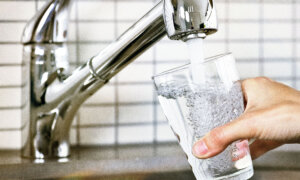Cassie Madsen found occasional massage therapy helpful for general relaxation during the height of her struggles with irritable bowel syndrome and anxiety. Still, she wasn’t expecting her massage therapist to offer an abdominal massage.
She'd never heard of such a thing. The duo first talked about Madsen’s gut function, including frequent constipation.
“She thought it would be helpful,” Madsen told The Epoch Times. “I felt a little better afterward. It wasn’t a magic cure or anything. I feel like sometimes it works for me, and sometimes it doesn’t make a big difference.”
Now a dietitian specializing in gut health and nutrition, Madsen said that while abdominal massage can’t replace the role food plays in digestion, the power of touch is helpful and accessible enough for symptom management that she often shares information about it with her clients.
“Think about the way you hold your body when you’re stressed or tensed, your gut is going to be similar in that reaction and actually probably a stronger reaction because of all the nerves in your gut,” Madsen said.
How It works
Enteric nerves line the walls of the
gastrointestinal tract, from the esophagus to the rectum. They help to coordinate muscle contractions, known as peristalsis and can operate with or apart from the central nervous system. This means that the enteric nervous system can be influenced by our emotions. Abdominal massage can be beneficial for manually loosening or stretching the muscles involved in digestion, relieving discomfort, and potentially stimulating bowel movements. Abdominal massage can be especially helpful as an alternative to laxatives and stool softeners, which can be harsh and have lasting effects on the gastrointestinal tract, according to Jillian Miller, a physical therapist with Brooks Rehabilitation who has training in colonic massage among her pelvic health specialization.
Fifteen minutes of daily abdominal massage significantly improves frequency of bowel movements, speeds up gut transit time, and improves constipation symptoms like straining, abdominal discomfort, bloating, incomplete stool evacuation, and stool obstructions in the rectum, according to a meta-analysis and systematic review of 1,431 adult patients. The results were published in the International Journal of Nursing Studies.
In the study, abdominal massage significantly raised weekly defecation frequency, decreased gut transit time, and lowered constipation symptoms compared to the control group. Nevertheless, it did not decrease laxative use.
Who Should Try Abdominal Massage?
Anyone who struggles with constipation—either infrequently or chronically—and has the manual dexterity to perform massage can try abdominal massage, Miller told The Epoch Times. It may be helpful to hire a trained specialist, at least for your first session, if you’re intimidated by starting.
Constipation is a common condition affecting about 16 of 100 adults and 33 of 100 adults 60 and older. Signs of constipation include having fewer than three bowel movements a week, hard or lumpy stools, painful passing of stools, or a feeling that not all stool has passed.
In extreme cases, constipation can cause swollen or torn tissue around the anus, hard stools backed up in the colon, and rectal tissues that slip out of the anus, known as rectal prolapse.
Miller noted that it’s common for constipation to become particularly problematic for hospitalized patients, as well as those at home recovering from surgery or debilitating injury. Immobility combined with medications that slow down peristalsis can contribute to constipation.
“When we use the term massage in the therapy world, we’re talking about techniques that are intended to provide temporary relief from pain or discomfort,” Miller said. “Big picture, long-term we want to see why you’re getting constipated, especially if it’s an ongoing problem.”
How to Do Abdominal Massage
A basic colon massage is straightforward enough that many people can try it without first seeing a therapist.
The standard technique involves the patient lying on their back with knees bent to relax the abdominal muscles, Miller said.
You begin by tracing the path of the ascending, transverse, descending, and sigmoid colon, applying moderate downward pressure. This sweeping stroke is done five to seven times. This is followed by repetitive C-shaped scooping strokes applied to five points where fecal matter tends to accumulate.
“While some variations exist—some techniques start at the sigmoid colon and work backward—I usually follow the natural digestive path, beginning on the right side and progressing toward the rectum,” Miller said of the second part of the massage. “Clinically, I always encourage my patients to try both directions and see what works best for them.”
Numerous videos and diagrams are available online, though some are in mirror-image format. The important thing to remember is that massage typically begins on the right, lower side and follows the natural flow of digestion.

(Illustration by The Epoch Times, Shutterstock)
Abdominal massage should not be painful or overly uncomfortable. Though injuries are rare, there are case reports of organ trauma associated with aggressive or vigorous massages.
One case report documenting pancreatic rupture secondary to abdominal massage concluded, “Appropriate abdominal massage is beneficial to relieve abdominal distension and constipation; however, vigorous abdominal massage should be avoided, as it can cause life-threatening damage to the internal organs and tissues of the abdomen.”
A Holistic Tool
Abdominal massage has roots in ancient Chinese culture—used by monks in monasteries as a holistic tool for physical, mental, emotional, and spiritual health. Called Chi Nei Tsang, or sometimes TaoTouch, it’s believed to address the root causes of disease.
The Chi Nei Tsang Institute states the technique can:
- Correct posture as it repositions organs and restores optimal function
- Alleviate stagnation of lymph and blood to strengthen the immune system
- Address stored, unprocessed emotions in the digestive system
The institute describes its approach as both body and energy work incorporated into practices like Kung Fu and Qigong.
“The truly holistic approach of Chi Nei Tsang is to strengthen the whole individual—working with the person instead of fighting against pathologies. Rather than focusing on problems, this modality puts the attention on the inner healing powers of the body, mind and spirit, which is effective in real, long-term healing from the source,” it states on its website.
Miller said a practical advantage of self-directed abdominal massage is that it can help people become more attuned to their bodies and the places in their colons where stool tends to get lodged. It’s a low-risk-free alternative to laxatives with no side effects, she added.
Supporting Abdominal Massage
To facilitate abdominal massage, Miller offered additional tips:
- Drink half your body weight in ounces of water a day unless your doctor says otherwise, and try to drink a large portion at room temperature and in the morning. That means someone weighing 160 pounds would shoot for 80 ounces of water daily.
- Get up and move by exercising, walking, or even standing, preferably early in the day.
- Wait for a strong urge before heading to the toilet.
- Don’t sit on the toilet for longer than 10 minutes, and avoid the urge to bear down or push.
- Position yourself with your knees higher than your hips (unless you’ve had a hip replacement), lean forward, relax, and maintain an even breath.
Miller noted that bowel dysfunction can sometimes be complex and serious and require professional intervention from a doctor or pelvic health specialist.
However, she said many of her patients using self-massage and other techniques learned in physical therapy enjoy significant, ongoing well-being. It’s common, Miller added, for new patients who haven’t had a bowel movement for a couple weeks to have one right after receiving abdominal massage, even before they leave the office.
“It helps them know if they do it and do it the right way, they actually will get results.”
Other Techniques
While massage is one technique, specially trained physical therapists can also use manual therapy techniques with pelvic floor muscles, such as trigger point release or instrument-assisted soft tissue massage. Trigger point release is sustained pressure applied to points to release tension, improve blood flow, and restore muscle function in the muscles that can become tight or stop working correctly.
You can find a pelvic health specialist through the American Board of Physical Therapy Specialties directory. Miller said many primary care doctors are familiar with local pelvic health therapists.
“Like a lot of things we do, we don’t want people to keep coming back to therapy,” she said. “We want to give them all the tools they need, so they can manage it on their own.”















